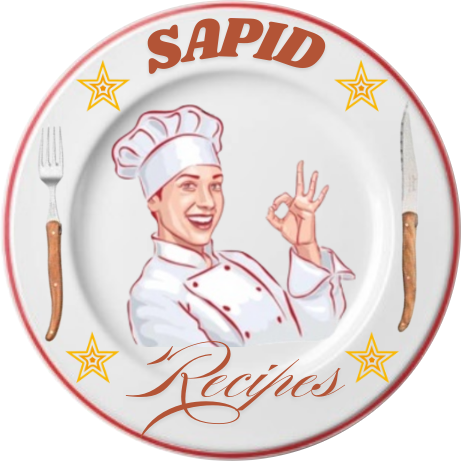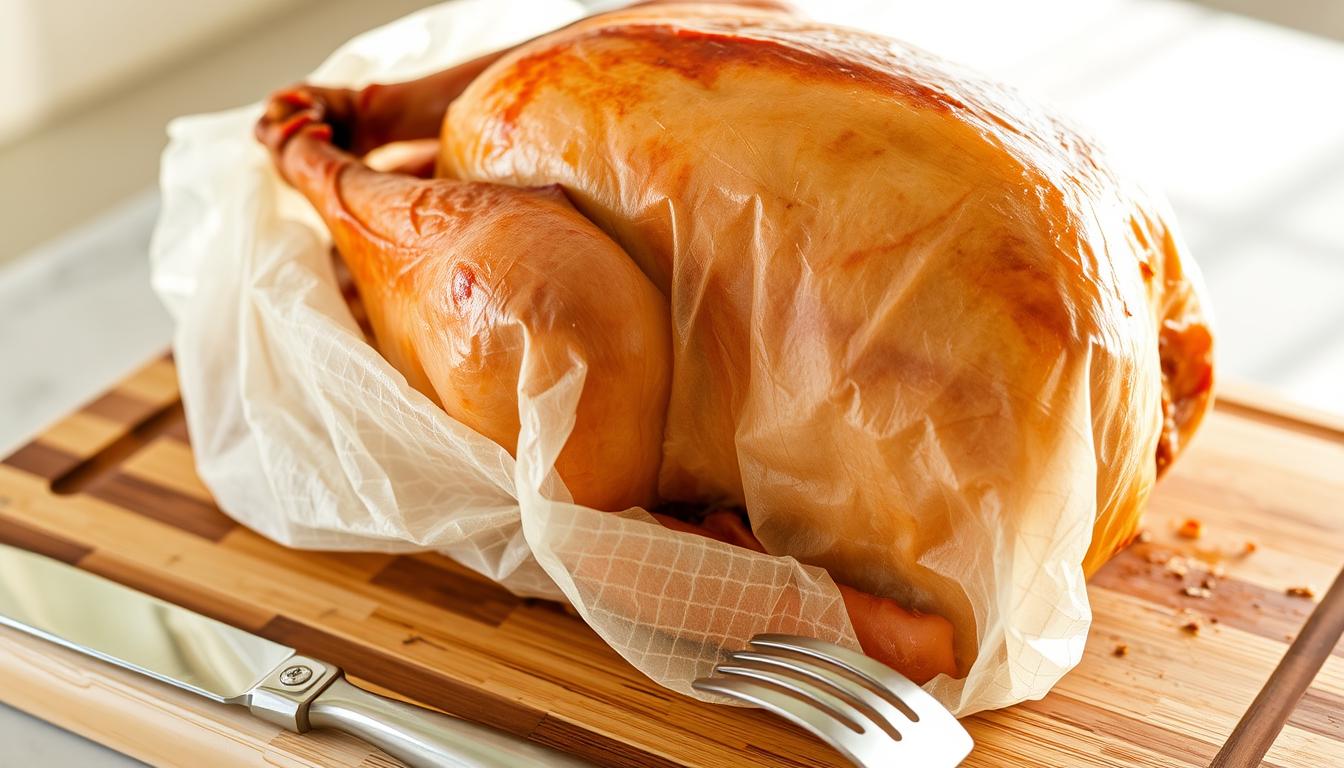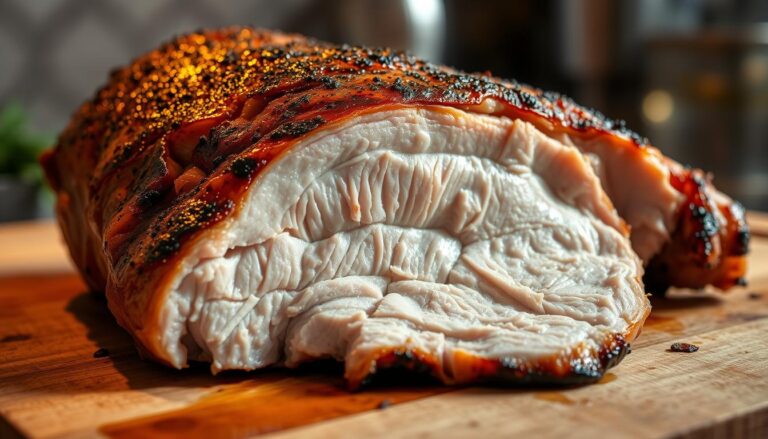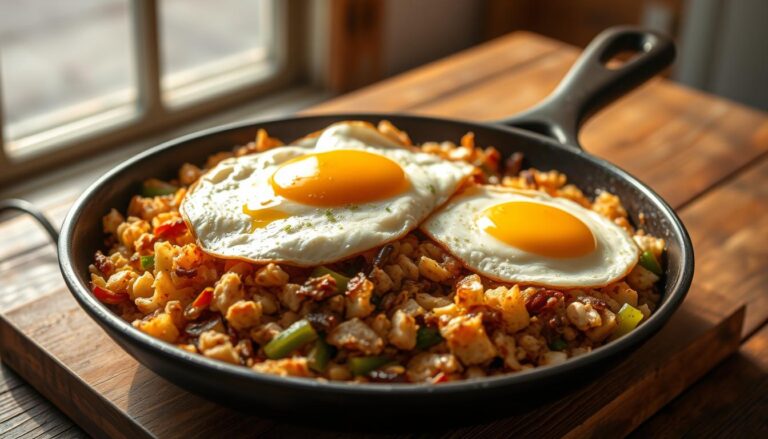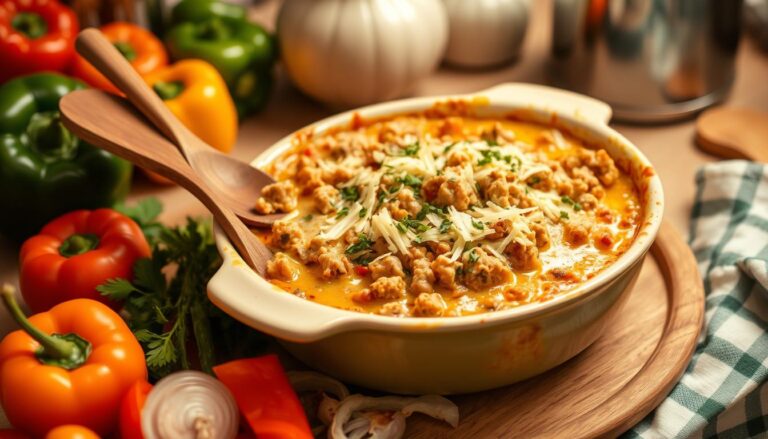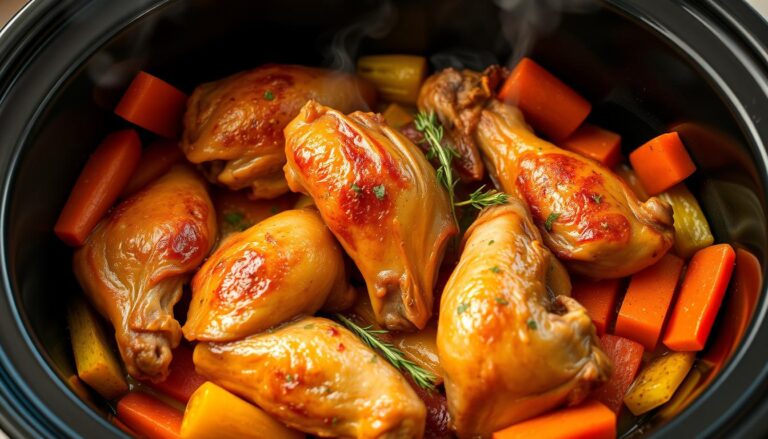How to Make Cheesecloth Turkey, Easy and Flavorful Dishe
Every Thanksgiving, I remember my grandmother’s secret to the most succulent turkey. Her legendary cheesecloth turkey technique is the key. It turns an ordinary holiday bird into a masterpiece of flavor and moisture.
Cooking with cheesecloth is more than a technique—it’s a tradition. It guarantees a perfectly roasted turkey. By draping the bird in cheesecloth, you lock in juices and get an incredibly golden-brown skin. Each slice is tender and delicious.
In this guide, we’ll show you how to make a cheesecloth turkey. It will be the centerpiece of your holiday meal. You’ll learn how to select the right turkey and master the cheesecloth roasting method. These professional techniques will elevate your cooking skills and impress your guests.
Whether you’re a seasoned home cook or trying something new this holiday season, this method will change your approach to roasting poultry. Get ready to discover a time-honored technique that turns an ordinary turkey into an extraordinary culinary experience.
Table of Contents
What is a Cheesecloth Turkey?
A cheesecloth wrapped turkey is a new way to cook turkey. It uses a special cotton cloth to keep the turkey moist. This makes your holiday turkey extra special.
Cheesecloth is a thin, loose fabric that helps with cooking. It’s great for making turkey taste better and feel softer.
Understanding Cheesecloth in Cooking
Cheesecloth is used for straining and wrapping herbs. But for roasting turkey, it’s a game-changer. It helps cook the turkey perfectly.
- Made from pure cotton
- Thin and permeable fabric
- Allows heat and moisture to circulate
- Typically available in different grades of weave density
Benefits of Using Cheesecloth
Using cheesecloth for turkey has many benefits:
- Moisture Retention: Keeps the turkey juicy
- Promotes Even Browning
- Helps Distribute Heat Uniformly
- Prevents Dry Meat Surfaces
Differences from Traditional Roasting
| Roasting Method | Cheesecloth Turkey | Traditional Roasting |
|---|---|---|
| Moisture Control | Superior Moisture Retention | Prone to Drying Out |
| Browning | Consistent, Even Color | Uneven Browning Possible |
| Flavor Infusion | Enhanced Herb Absorption | Limited Flavor Penetration |
Learning about cheesecloth can make your turkey recipe amazing. It takes some practice but is worth it. Your guests will love it.
Preparing Your Turkey
To get your turkey ready for a perfect cheesecloth roast, you need to prepare it carefully. The right steps can turn an ordinary bird into a culinary masterpiece. This will surely impress your dinner guests.
Selecting the Right Turkey Size
When picking a turkey for cheesecloth roasting, keep these tips in mind:
- Choose a turkey that weighs 12-15 pounds for the best roast
- Remember, plan for 1¼ pounds per person when figuring out size
- Opt for fresh turkeys over frozen ones when you can
- Stay away from turkeys that have been pre-injected with salt solutions
Thawing and Cleaning the Turkey
Thawing your turkey right is key when using cheese cloth for roasting. Here’s what to do:
- Thaw in the fridge: It takes about 24 hours for every 4-5 pounds
- For a 12-15 pound turkey, thaw for 3-4 days
- Pat the turkey dry with paper towels before seasoning
- Take out the giblets and neck from the cavity
Seasoning Your Bird
Seasoning is crucial for a delicious cheesecloth roasted turkey. Make a flavorful herb butter by mixing:
- ½ cup melted butter
- 4-5 sprigs each of fresh sage, thyme, and rosemary
- 3 teaspoons sea salt
- 4 minced garlic cloves
- Zest of one lemon
“The secret to a perfect turkey is in the preparation and seasoning.”
Massage the herb butter under the skin and all over the turkey. This ensures even flavor distribution. It also helps keep the turkey moist and flavorful when using the cheesecloth roasting method.
Choosing the Right Cheesecloth
Choosing the right cheesecloth for turkey roasting can greatly improve your cooking experience. Knowing the best cheesecloth for turkey roasting helps you get a moist and tasty turkey.
Types of Cheesecloth for Turkey Roasting
There are several types of cheesecloth for turkey roasting:
- Lightweight cheesecloth (Grade 10)
- Medium-weight cheesecloth (Grade 50)
- Heavyweight cheesecloth (Grade 90)
Where to Purchase Quality Cheesecloth
You can find great cheesecloth for turkey roasting from many places:
- Kitchen supply stores
- Online retailers like Amazon
- Specialty cooking websites
- Local grocery stores
Best Practices for Cheesecloth Usage
Here are some expert tips for using cheesecloth for turkey roasting:
- Choose a triple-layer thickness for the best moisture retention
- Soak cheesecloth in melted butter and white wine before roasting
- Make sure cheesecloth fully covers the turkey
- Replace cheesecloth if it gets too dry during cooking
| Cheesecloth Grade | Recommended Use | Thickness |
|---|---|---|
| Grade 10 | Light straining | Thin |
| Grade 50 | Medium straining, ideal for turkey | Medium |
| Grade 90 | Heavy-duty applications | Thick |
By following these tips, you’ll get a perfectly roasted turkey. It will be moist, flavorful, and a hit with your guests.
The Brining Process
Starting a turkey wrapped in cheesecloth means learning about brining. Brining turns a regular turkey into a juicy, flavorful dish for your holiday. It’s not always needed but can make the meat more moist and tasty.
Brining is key for a cheesecloth turkey recipe. It lets seasoning soak deeper into the meat. This makes the flavor more even.
Why Brine Your Turkey?
Brining does more than add flavor. It:
- Keeps moisture in during cooking
- Boosts the turkey’s natural taste
- Makes the meat tenderer
- Improves how well seasoning is absorbed
Basic Brine Recipe
For a great turkey wrapped in cheesecloth, use this brining method:
| Ingredient | Quantity | Purpose |
|---|---|---|
| Water | 7 quarts | Base liquid |
| Coarse Salt | 1.5 cups | Primary seasoning |
| Bay Leaves | 6 whole | Aromatic flavor |
| Whole Coriander Seeds | 2 tablespoons | Depth of flavor |
How Long to Brine
The brining time depends on the turkey’s size. Typically, 8 to 18 hours works best. For an 18-20 pound turkey, aim for 12-14 hours. Always keep the turkey cold during brining, at 40 degrees Fahrenheit or below.
“Brining is an art that transforms a good turkey into an extraordinary meal.” – Professional Chef
Take the turkey out of the brine an hour before roasting. Pat it dry inside and out. This prepares it for your cheesecloth turkey recipe.
Preparing the Cheesecloth
Learning how to use cheesecloth for turkey is key. It can turn a simple roasted turkey into a feast. The right steps make the turkey moist and full of flavor, wowing your guests.
Prepping the Cheesecloth for Roasting
Here’s how to get your cheesecloth ready for roasting:
- Choose a high-quality, food-grade cheesecloth
- Cut it to 17 inches on each side
- Make 4 layers for better moisture
- Make sure it’s clean and sanitized
Adding Herbs and Seasonings
Make your turkey even more delicious with herbs. Mix a flavorful butter with these ingredients:
| Ingredient | Quantity |
|---|---|
| Unsalted Butter | 1/2 cup, cubed |
| White Wine | 1/4 cup |
| Fresh Herbs | 4 sprigs thyme, 2 rosemary stems |
Sizing Your Cheesecloth
Getting the cheesecloth size right is important. Fold it into a square that fits your turkey. Melt the butter, mix in wine and herbs, and soak the cheesecloth evenly.
Pro Tip: The key to a perfectly moist turkey is a well-prepared cheesecloth that locks in flavor and prevents excessive drying.
Roasting Techniques
Mastering cheesecloth turkey roasting needs precision and patience. The cheesecloth method turns a regular turkey into a culinary masterpiece. It ensures moisture and gets that golden-brown skin everyone loves.

- Preheat your oven to 450°F first
- Place the turkey legs-first in the roasting pan
- Cook at high temperature for the first 30 minutes
- Lower the heat to 325°F for the rest of the time
Optimal Roasting Temperatures
Your success with cheesecloth turkey roasting depends on the right temperature. Start with high heat to crisp the skin. Then, lower the temperature to cook the meat evenly.
| Turkey Weight | Cooking Time | Internal Temperature |
|---|---|---|
| 10-14 lbs | 2.5-3 hours | 170-175°F |
| 15-19 lbs | 3-4 hours | 170-175°F |
| 20-24 lbs | 4-5 hours | 170-175°F |
Monitoring Cooking Progress
Use a meat thermometer to check the internal temperature. Aim for 170-175°F in the thickest part of the thigh. Remove the cheesecloth during the final 45-60 minutes for skin browning.
“Perfect roasting is an art of patience and precision” – Culinary Experts
After roasting, let your turkey rest for 20 minutes before carving. This ensures juicy, flavorful meat.
Basting Your Turkey
Cooking with cheesecloth needs a smart basting plan to keep your turkey juicy and tasty. Basting is key to making a delicious cheesecloth turkey recipe that will wow your guests.
Basting spreads heat evenly and stops the turkey from drying out while it roasts. The right method can turn a simple turkey into a feast for the eyes and taste buds.
Why Basting Matters
When using cheesecloth, basting is even more important. The cloth keeps moisture in, but you must also keep the turkey’s surface wet. Good basting means:
- Even cooking all through the bird
- Better flavor from seasonings
- Prevents dry meat
- A stunning golden-brown outside
Basting Techniques
For a top-notch cheesecloth turkey recipe, follow these basting tips:
- Use a mixture of butter and white wine for the best taste
- Baste every 30 minutes while cooking
- Use a long-handled basting brush or turkey baster
- Work fast to lose less heat in the oven
Basting Frequency and Tips
Consistency is the secret to great basting. For a 15-pound turkey, baste every 30 minutes. Start basting after the first hour, keeping the cheesecloth moist.
Pro tip: Keep your basting liquid warm to prevent cooling down the turkey and extending cooking time.
Take off the cheesecloth in the last 45 minutes to let the skin crisp and brown. Keep basting with pan juices to add flavor and moisture.
Resting and Carving the Turkey
After your cheese cloth turkey comes out of the oven, the last steps are key. They make your meal unforgettable. Resting and carving turn your turkey into a true feast.
The Importance of Resting
Resting your turkey is a step many miss. When you take it out of the oven, it keeps getting hotter. Letting it rest for at least 30 minutes makes each slice juicy and full of flavor.
- Cover the turkey loosely with foil
- Keep the turkey in a warm area
- Avoid cutting into the meat immediately
Best Carving Techniques
To show off your turkey, you need the right tools and method. Use a sharp knife and a big cutting board for neat slices.
- Remove the legs and thighs first
- Slice breast meat against the grain
- Aim for uniform 1/4-inch thick slices
- Separate white and dark meat on the platter
Serving Suggestions
Show off your perfectly roasted turkey. Arrange the slices neatly on a warmed platter. Add fresh herbs for a touch of elegance. Your guests will be amazed by your cooking.

Cleanup and Storage Tips
After you’ve made your tasty cheesecloth wrapped turkey, it’s important to store it right. Make sure to put your leftover turkey in the fridge within two hours of eating. This keeps it safe and fresh.
For storing, use airtight containers. This way, your turkey stays good for 3 to 4 days in the fridge.
To clean your cheesecloth, wash it with warm water and a mild soap. If it’s still in good shape, you can use it again for more turkey recipes. You can also freeze turkey for up to 6 months for later meals.
Keep your roasting pans clean to make them last longer. Wash them with hot, soapy water and dry them well to avoid rust. Store your cooking tools in a cool, dry spot, away from sunlight. These steps help keep your turkey and cooking gear in top shape for your next meal.
FAQ
What is cheesecloth and why use it for roasting a turkey?
How long should I soak the cheesecloth before using it?
Can I reuse cheesecloth for multiple turkey roastings?
What type of wine works best for the cheesecloth mixture?
How often should I baste a turkey when using cheesecloth?
Do I need to brine my turkey if I’m using the cheesecloth method?
What size cheesecloth should I use for my turkey?
Can I use cheesecloth with other types of poultry?
Did You Try This Recipe ?
I like it
I like it
